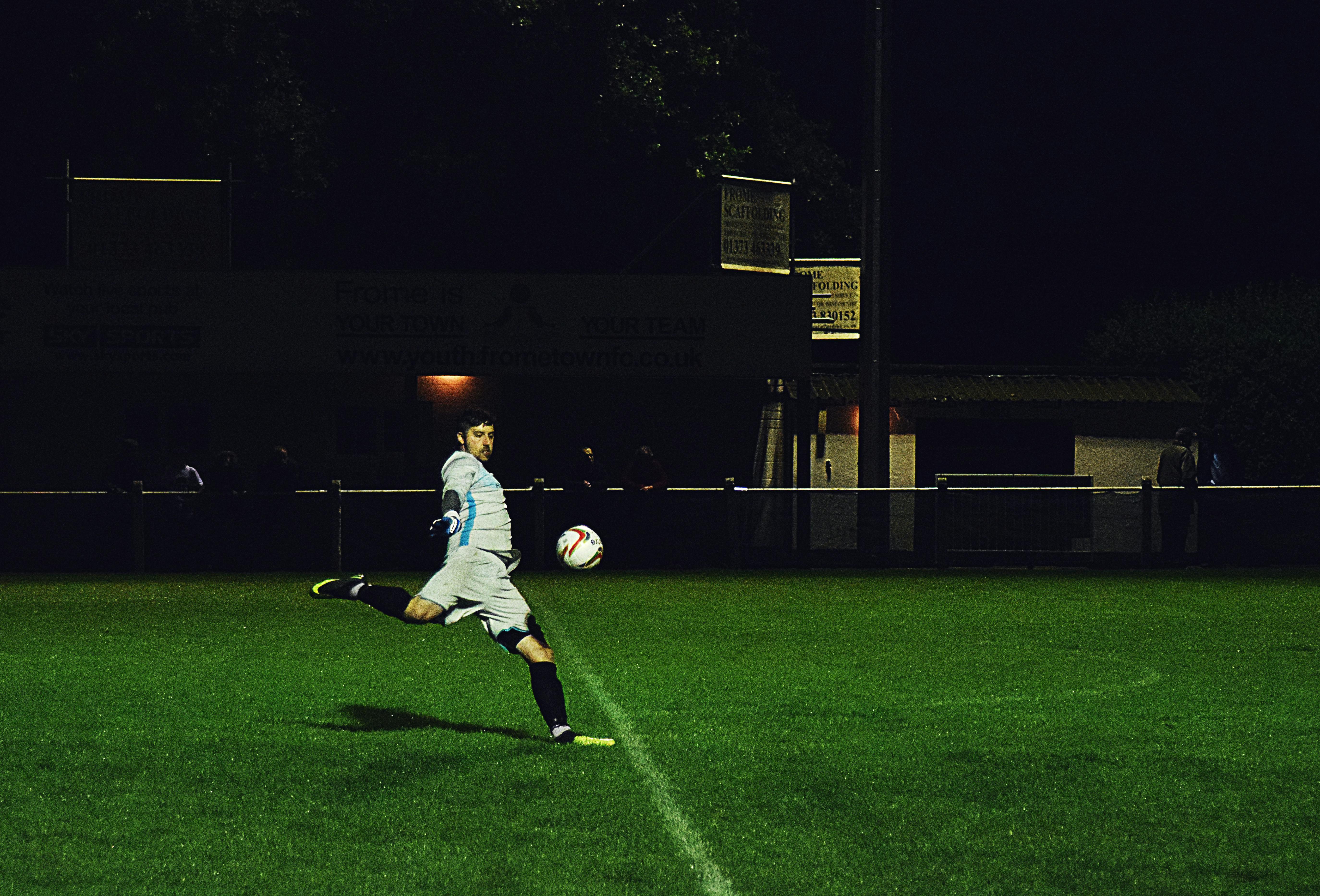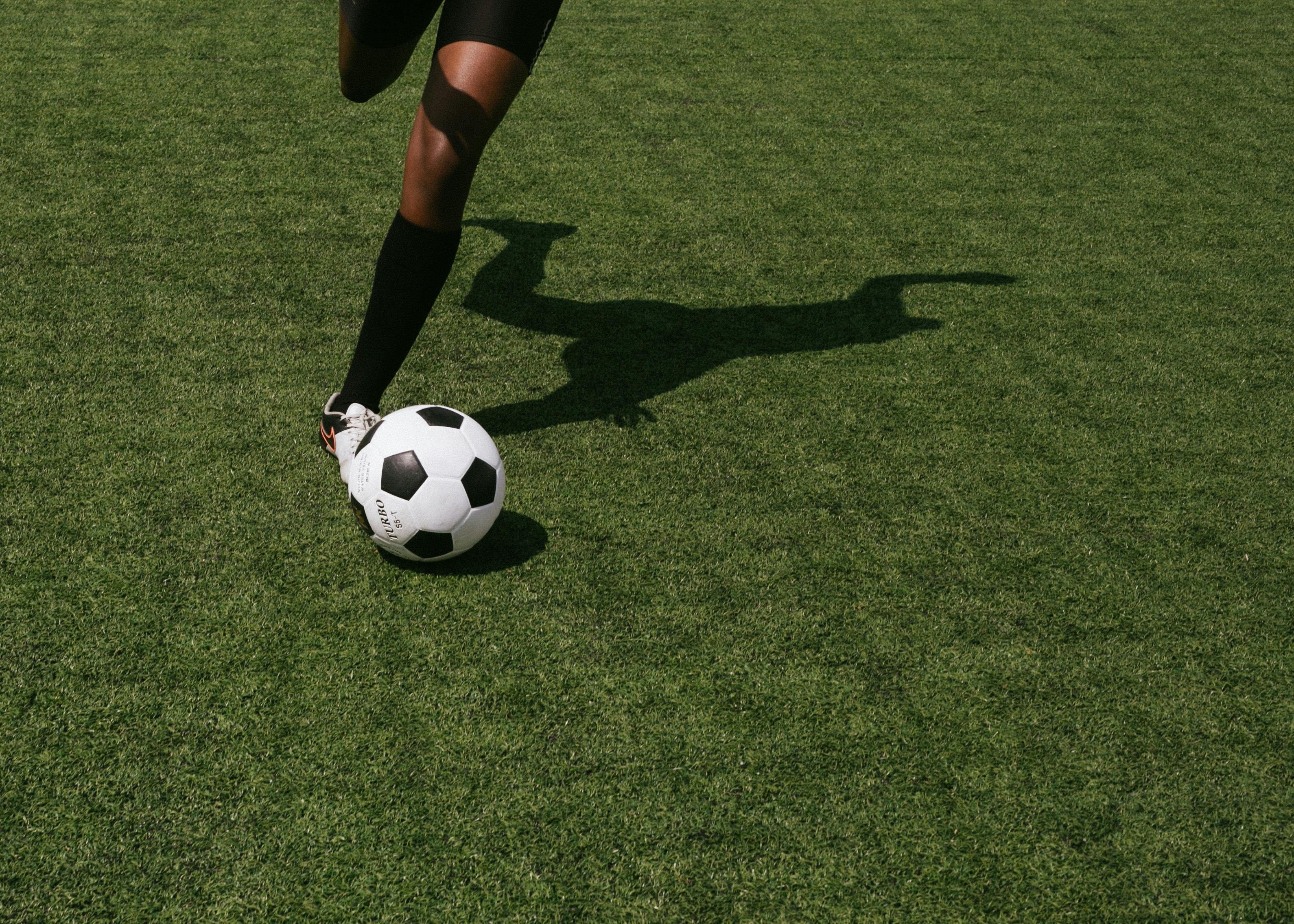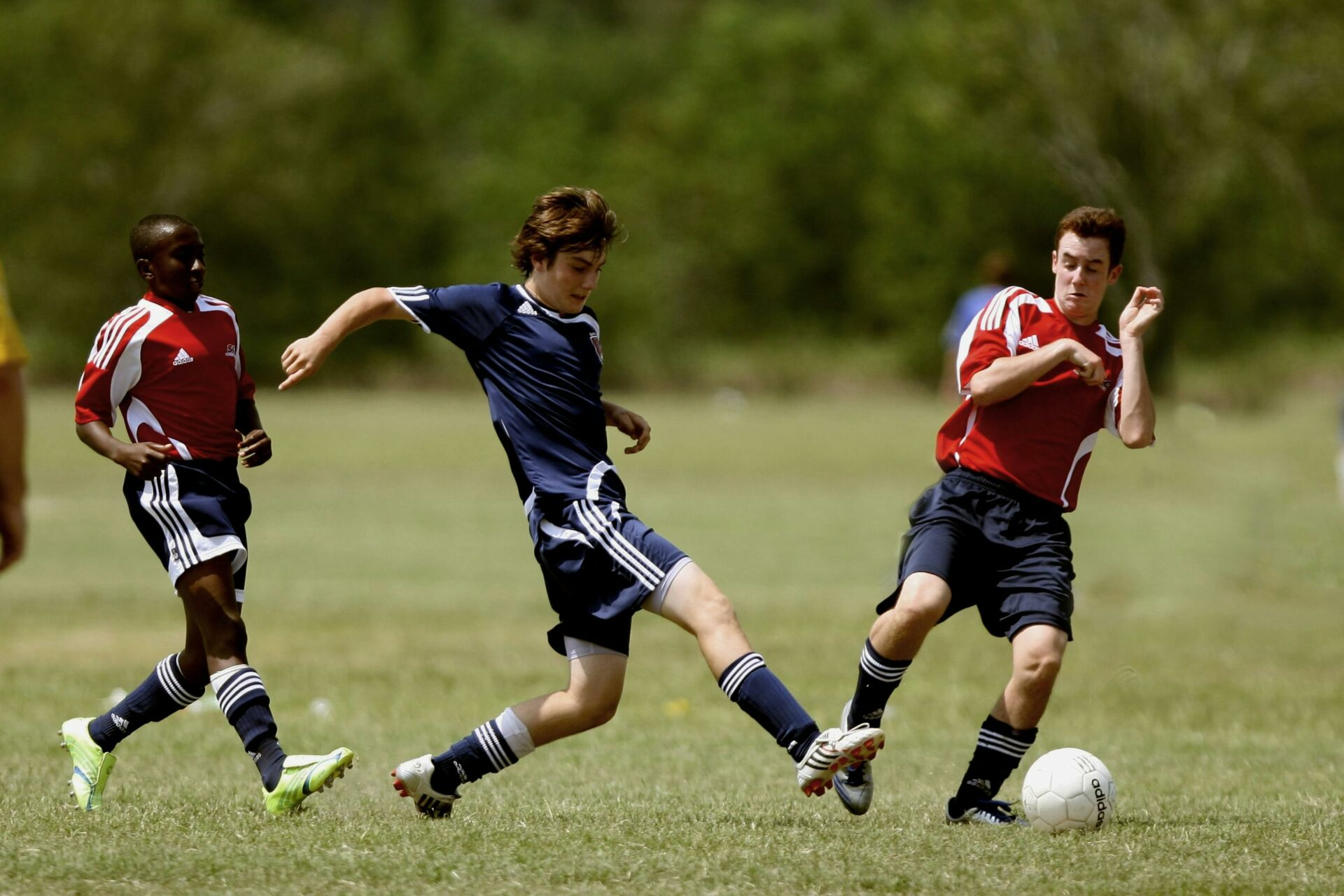Kicking a soccer ball is an important skill to master for any soccer player. Knowing how to kick a soccer ball correctly will help you become a more confident and successful player. In this diagram, we will show you the correct way to kick a soccer ball and explain the steps involved in the process. By following these instructions, you can learn how to kick a soccer ball with power, accuracy, and control.Step 1: Place your non-kicking foot next to the ball. Make sure your toes are pointing in the direction of the intended target.
Step 2: Place your kicking foot behind the ball. Angle your toes so they are facing in the same direction as your planted (non-kicking) foot.
Step 3: Slightly bend your knee and hold your arms out for balance.
Step 4: Using a short, quick motion, thrust your kicking foot through the center of the ball and follow through with a pointed toe.
Step 5: Keep your eyes on the ball until it reaches its target. Aim to keep it low and on the ground for more accuracy.
Kicking Technique Basics
Kicking is an important part of the game of football and can be a powerful weapon in a team’s arsenal. It is important for footballers to understand the basics of good kicking technique in order to be successful. The key elements of a good kick are accuracy, power, and distance.
Accuracy is one of the most important aspects of kicking since it allows the ball to travel exactly where it needs to go and puts the player in control of the play. To achieve accuracy, it is important to keep your eyes focused on the ball and your body properly balanced. When kicking, it is best to kick with the instep of your foot, as this will maximize accuracy and minimize any unnecessary movement that could disrupt your aim.
Power is another important element in a successful kick. Power comes from generating momentum with your leg as you swing it forward towards the ball. It also comes from using your hips and core muscles to generate force when striking through the ball. To make sure you generate maximum power when kicking, make sure you step into your kick with force and follow through with your leg after contact has been made with the ball.
Distance is another crucial element when it comes to kicking. Distance can be increased by using more power during your swing but also by controlling where you strike the ball on your foot. Striking near the toe can give more lift on the ball while striking closer to the heel will give more power and less rise on the ball, allowing for greater distance when kicked properly.
In conclusion, mastering these three key elements – accuracy, power, and distance – will help footballers become better kickers and become more effective weapons in their team’s arsenal. By practicing proper technique for each element and making sure that they stay focused on their target during each kick, players will be able to maximize their potential on every play they make in a game situation.
Plant Foot Positioning
Plant foot positioning is an important aspect of plant health and growth. It involves the placement of the plant’s feet in soil or other growing medium in order to facilitate proper root development, water and nutrient uptake, and the overall health of the plant. Proper plant foot positioning is essential for proper growth and development, as it helps to support the plant’s structure and provide a stable foundation for it to grow.
When planting a new seedling or transplanting an existing one, it is important to ensure that the plant’s feet are properly placed in the soil. This will help to prevent root damage due to compaction, which can lead to stunted growth and decreased yields. It is also important that the feet are placed evenly in the soil in order to ensure even absorption of water and nutrients throughout the root system. If one foot is placed too deeply or too shallowly, this can cause uneven absorption of nutrients which can lead to an imbalance in nutrition levels within the plant, resulting in poor growth.
It is also important to consider how far apart each foot should be placed when planting a seedling or transplanting an existing one. If they are placed too close together, then this can cause excessive competition between roots for resources such as water and nutrients which may result in one foot becoming undernourished while another may become overly nourished. On top of this, if they are too close together then this can also lead to overcrowding of roots which can reduce their ability to uptake essential nutrients from the soil.
Finally, when considering how far apart each foot should be planted it is also important to consider how much space each root will need in order for it to grow properly without becoming overcrowded or stunted due their being too close together. Generally speaking, each foot should have at least three inches of space between them when planted so that there is enough room for each root system to develop properly without competing with one another for resources such as water and nutrients.
In conclusion, proper plant foot positioning is an essential aspect of successful gardening and horticulture practices as it helps ensure that plants have access to enough resources such as water and nutrients in order for them to grow properly and develop into healthy plants that will produce high yields over time.
Swing Through Motion
Swing Through Motion is an effective way to move the body. It involves using the power of momentum to increase the speed and efficiency of movements. This technique can be used in a variety of physical activities, including sports or exercise programs. The goal is to move the body in a smooth, continuous motion, allowing for maximum efficiency and power. By using this technique, athletes and other fitness enthusiasts can increase their speed, agility, and strength while reducing the risk of injury.
The key to performing Swing Through Motion correctly is to maintain good form while using momentum to generate force. This involves keeping your feet firmly planted on the ground and transferring your weight from one foot to the other as you move through each step. It also requires coordination between all parts of your body, including your arms and legs, as you swing through each step. Additionally, it is important to focus on proper breathing throughout the movement to ensure that you are getting enough oxygen and energy into your muscles.
In addition to increasing speed and agility, Swing Through Motion can help improve balance and stability. By ensuring that all parts of your body are working together in harmony, you are able to better control your movements while maintaining balance. This is especially beneficial for activities such as running or jumping where maintaining equilibrium is vital for success. Furthermore, this technique can help reduce impact on joints by providing a smoother transition between steps.
Overall, Swing Through Motion is an effective way to improve physical performance by increasing power output while reducing the risk of injury. With practice and dedication, anyone can learn how to properly perform this movement pattern in order to achieve optimal results from their fitness routine.
Identify the Problem
Once you have identified the problem, it is important to take the necessary steps to ensure that the situation is addressed properly. You must figure out what exactly is causing the problem and then come up with a plan of action. This may involve research, talking to other people, or simply brainstorming ideas. Once you have a clear understanding of the problem, you can begin to develop a plan of action that will help you solve it.
Gather Information
The next step in solving a problem is to gather all of the necessary information. This includes researching any possible solutions, talking to experts or professionals who may have experience in dealing with similar issues, and consulting with other people who may be able to provide helpful insight or advice. Once you have obtained as much information as possible about the issue, you can begin to form an effective plan for addressing it.
Develop a Plan
Once you have gathered enough information about the problem at hand, it is time to develop an effective plan for addressing it. This involves evaluating all possible solutions and narrowing them down to those that are most likely to achieve success. It is important to consider any potential risks associated with each option and determine which one will be most beneficial in resolving the issue quickly and effectively.
Implement Solution
Once you have developed an appropriate plan for addressing your problem, it is time to implement it. This involves taking action on the various steps outlined in your plan and making sure that every aspect of it is carried out correctly and efficiently. It is important to monitor progress throughout this process so that any potential issues can be quickly addressed before they become major problems.
Follow Through Steps
The final step in solving any problem is following through on all of the necessary steps outlined in your plan of action. This includes ensuring that all aspects of your solution are implemented correctly and staying on top of any changes or developments that may occur throughout this process. By doing this, you can ensure that your solution will be successful and resolve the issue at hand as quickly as possible.

Aiming at Target
Achieving one’s goals requires a clear aim and dedication. It is important to know what our targets are and how to achieve them. Setting realistic goals that are achievable within a certain time frame will help us stay focused and motivated. It is also essential to have a plan of action that outlines the steps needed to reach the target. This will ensure that we stay on track and don’t get distracted from our goal. Additionally, it is important to have a support system in place that will help us when we need it most. Having a mentor or someone to talk to can provide us with guidance and advice when we need it most.
It is also essential to have the right attitude and mindset when aiming for our targets. Having an optimistic outlook that is focused on success rather than failure will help us stay motivated and achieve our goals. Being organized, disciplined, and persistent will also be beneficial as it will help us focus on the task at hand and make sure that we reach our targets in time.
Finally, it is important to remember that striving for excellence should always be our aim when setting targets for ourselves. Aiming for perfection may not always be feasible but striving hard towards excellence will definitely help us reach our goals in life.
Adjusting Power and Accuracy
Power and accuracy are two of the most important factors when it comes to shooting with a firearm. It is important to make sure that these factors are adjusted correctly for the best results. By adjusting power and accuracy, you can ensure that your shots will be accurate and powerful enough to hit their target.
One way to adjust power and accuracy is by adjusting the sights of your firearm. This will allow you to adjust the point of aim so that your shots will be more accurate. You can also adjust the recoil of the firearm, which will help control the power of your shots. This can be done by using various types of recoil-reducing devices or by simply changing out your ammunition.
Another way to adjust power and accuracy is by adjusting your trigger pull. This will allow you to make sure that your shots have a consistent feel and follow-through every time you shoot. You can also adjust your grip on the firearm, which will also help improve accuracy and control over your shots.
Finally, you can use different types of ammunition for different purposes when shooting with a firearm. Different types of ammunition have different levels of power and accuracy, so it’s important to choose the right type for each situation. For example, if you are shooting at a longer range, then choosing a higher powered round might be beneficial in order to get better accuracy at longer distances.
By adjusting power and accuracy, you can ensure that all of your shots are as accurate as possible while still having enough power to reach their target accurately. Whether it’s adjusting sights, recoil or trigger pull, there are plenty of ways that you can improve both power and accuracy when shooting with a firearm.
Scissor Kick Techniques Diagrams
Scissor kick is an advanced football move that requires a lot of practice and skill to perfect. It can be used to quickly change the direction of the ball or to evade an opponent. The technique involves kicking the ball with both feet in a scissoring motion, making contact with both feet simultaneously. To help you understand and master this move, we have compiled diagrams of scissor kick techniques that show the different steps involved in executing it. The diagrams provide a visual representation of how to perform the move, helping you understand each step and practice accordingly. With these diagrams, you can learn the technique quickly and become an expert in no time.
The diagrams are divided into sections that explain each part of the scissor kick in detail. First, they explain how to position your body before you start the motion, which is important for accuracy and power. Then they demonstrate how to kick off from both feet while maintaining balance. Finally, they show how to use your upper body strength for additional power and accuracy when striking the ball. All these steps are clearly illustrated through diagrams so that you can easily follow them and practice properly.
Scissor kicks are an integral part of football and mastering them will give you an edge over your opponents. With our diagrams of scissor kick techniques, you can easily get a good understanding of this advanced move and start practicing right away!

Conclusion
Kicking a soccer ball correctly is an essential skill for any soccer player. The diagram provided in this article gives a comprehensive overview of the process, from the correct positioning of your body to the follow-through step. Following these steps will ensure that you can kick a soccer ball with power and accuracy.
The kick will also be more accurate if you practice regularly. Mastering the skills necessary to kick a soccer ball correctly will take time and practice, but it is worth it in the end as it adds another tool to your arsenal as a soccer player.
Whether you are a beginner or experienced player, following these steps when kicking a soccer ball will help you improve your technique and increase your success rate when playing the game.




